Radishes are usually eaten raw, at least that's the way I always ate them. Then I came across a recipe in Lydia Matticchi's
Italian-American Kitchen that featured cooked radishes and I've frequently cooked them ever since. They are delicious when cooked, and you can cook the nutritious greens too!
One of the troubles with going nuts at a farmers market on the weekend is using everything before it goes bad. I had a riot of vegetables that needed to be cooked and eaten, so this week's vegetarian meal shows the outcome. When I cook vegetable-only meals, I like to find new ways to flavor them. I came up with sage, fennel seed and rosemary to bring some punch to the dish. The egg on the cutting board ended up going back in the fridge.
ON THE CUTTING BOARD:

Whole-grain quinoa, miso, cabbage, potatoes, asparagus, garlic, onion, carrots, cherry tomatoes, radishes, egg, parmesan cheese, parsley, avocado, spinach, lemon
Other pertinent characters: dried sage, dried basil, fresh rosemary, dried oregano, paprika, fennel seed, seasalt, crushed red pepper, fresh ground black peppercorns
STEP ONE:

Cook 1 cup of quinoa in 2 cups of miso. One cup of quinoa will feed two people, so adjust accordingly. I use whole-grain quinoa since I think the more common variety is bland. The whole-grain imparts a bit of a nutty flavor. Make an extra cup of miso and set aside to add to the dish later.
STEP TWO:


Cut the potatoes in rounds and cut in half. Chop the onions and garlic. Heat 1 T. of oil (I used canola) and add the potatoes. Allow to cook on medium heat for about 4 minutes, turning when golden on one side and then add the onions and garlic. Add 1 T. dried sage, 1 tsp. dried basil, 1 tsp. fennel seed, 1/2 tsp. seasalt, 1/4 tsp. crushed red pepper (or to taste), 1/2 tsp. paprika. Stir. You may need to add more oil. Stay attentive and allow to cook for a few more minutes.
STEP THREE:

Cut radishes in half and add to the skillet. Cook for about 4 minutes on low heat.
STEP FOUR:

Chop the carrots and add to the skillet. Cook for about 5 minutes on low heat. Add the one cup of reserved miso and stir.
STEP FIVE:

Add chopped cabbage, asparagus, tomatoes and one-quarter sprig of rosemary leaves, chopped. Cook on medium heat for about 4-5 minutes. Believe it or not, it's the same cabbage from weeks ago! It wasn't an uninvited guest, but it appears to want to stick around forever.
STEP SIX:

Throw in the spinach and cook for another minute.
STEP SEVEN:


Arrange on a platter, squeeze fresh lemon juice on top, generously douse with freshly ground pepper and if you're vegan, you're good to go. If not, and you choose to, grate some parmesan (or any cheese you like) on top. Garnish with parsley. I used the avocado in a spinach salad.
Miso is a complete protein (all 9 amino acids), so it's a good choice for vegans and vegetarians. It's good for everyone! It has vitamin B2, vitamin E, vitamin K, calcium, iron, potassium, choline and lecithin. It's also high in dietary fiber.
ALLA VOSTRA SALUTE!




















































